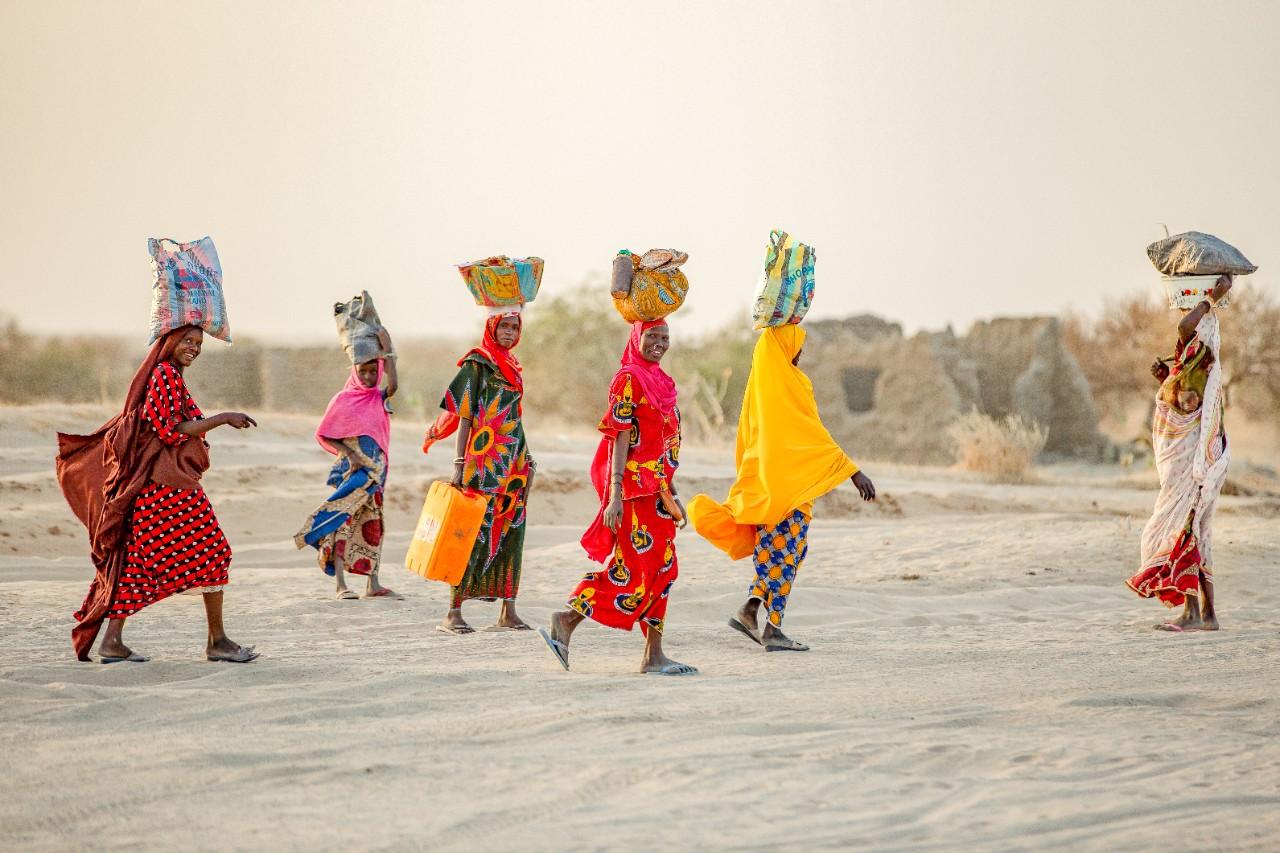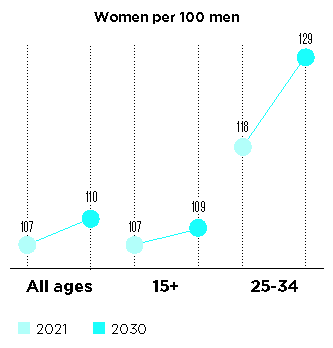
UNDP-UN Women initiative, in collaboration with the Pardee Center, generates new poverty forecasts accounting for the effect of COVID-19
We’ve heard the dire economic predictions and warnings that COVID-19 is pushing more people into extreme poverty. But new poverty forecasts commissioned by UN Women and UNDP, and conducted by the Pardee Center for International Futures at the University of Denver, offer the first global estimates of extreme poverty by sex and age, which take into account the economic fallout from the pandemic. The data indicates that COVID-19 has unleashed a powerful boomerang effect that reverses the progress we’ve already made.
Not surprisingly, these data also confirm that women and girls – already overrepresented among the world’s extreme poor by 6 million – will continue to be those hardest hit. Yet, these figures are only the tip of the iceberg. While they account for the overall economic slowdown, they do not reflect the specific challenges faced by women, such as their higher job losses, shrinking work hours and greater care burdens.
Women and girls will continue to be the majority of the poor
Unless measures are taken to shield the most vulnerable, by this time next year 435 million women and girls will be living on less than $1.90 a day worldwide – including 47 million specifically impoverished by COVID-19.
These new forecasts signal a worrying reversal in gains towards eradicating poverty. Poverty rates had been declining steadily since the late 1990s – and the number of women living in extreme poverty was expected to fall by 2.7% between 2019 and 2021. However, new poverty forecasts indicate a rise of some 9.1%. The result looks to be a powerful boomerang effect that reverses the progress we’ve already made.
Global population living below the international poverty line by sex, all ages
Girls and young women stand to be particularly affected by extreme poverty
The age profile of poor females confirms that girls 0-14 and young women 15-24 account for nearly two in every three extreme poor females (43.7% and 17.2% respectively), a distribution that is projected to change little by 2030.
Percentage distribution of poor females by age
Gender gaps in extreme poverty, already biased against women, will worsen as a result of the crisis
Among the population over the age of 15, for every 100 men expected to live in extreme poverty, there will be 105 poor women. Yet gender poverty gaps are deepest in prime reproductive years. Globally, in 2020, there will be 119 poor women for every 100 poor men aged 25–34, a ratio that is expected to increase to 121 women per 100 men by 2030. Women from South Asia will be particularly affected – by 2030 there will be 129 poor women for every 100 men living in extreme poverty. These data reveal that women’s risk of falling into poverty is most acute when they are most likely to have young children in the home to care for, as well as in late adulthood.
Women’s increased poverty at these life stages is not coincidental. Over the course of their lives, women are more likely to have prioritized family obligations over paid work, which can adversely affect their incomes in prime working years. This also has a ripple effect on their income security in old age. Among those aged 55 and over, women make up the majority of those living in extreme poverty (53 per cent). The 2021 projections indicate that 38 million women aged 55+ globally will be living in extreme poverty compared to 34 million men.
Poor women for every 100 poor men in South Asia

Most poor women will continue to live in sub-Saharan Africa, but more women in Central and Southern Asia will also sink into poverty
Data about where women are poorest are equally eye-opening. Today, 58.9% of the world’s poorest women live in sub-Saharan Africa, a share that is expected to grow to over 71.1% by 2030. What is equally alarming is that in Central and Southern Asia the economic fallout of the pandemic is projected to bring with it a resurgence in extreme poverty. The female poverty rate, pre-COVID-19, was projected to be 10 per cent in 2021, but the figure is now projected to reach 13 per cent. Before the pandemic, projections for the region suggested that by 2030 it would comprise only 15.8 per cent of the world’s women and girls living in extreme poverty. The revised projections now put that figure at 18.6 per cent.
Percentage distribution of poor females by region
● Sub-Saharan Africa ● Central and Southern Asia ● Latin America and the Caribbean ● Eastern and South Eastern Asia ● Northern Africa and Western Asia ● Europe and North America ● Oceania excluding Australia and New Zealand ● Australia and New Zealand
Closing pervasive gender poverty gaps can take several decades
Among those aged 25–34, a gender poverty gap currently exists in 75 of 117 low- and middle-income countries. Only eight of these countries are expected to close this gap by 2030. Unless policies are adopted immediately to prevent women’s further impoverishment, the remaining 67 countries might need more than half a century to close their gender poverty gaps.
Number of countries by decade in which the gender poverty gap among persons aged 25–34 will be closed
In addition, economic impacts are compounded by other factors – such as increased childcare burdens, attitudinal bias, a slower recovery, or reduced public and private spending on services such as education or childcare, which are pushing many women to leave the labour market, in some cases permanently.
Countries by years remaining to close the gender poverty gap, among persons aged 25–34
Note: The designations employed and the presentation of material on this map do not imply the expression of any opinion whatsoever on the part of UN Women concerning the legal status of any country, territory, city or area or of its authorities, or concerning the delimitation of its frontiers or boundaries
The good news – poverty can be eradicated
The new UNDP/UN Women data also calculates the cumulative cost of lifting the world out of extreme poverty by 2030. Using a market-basket-of-goods approach to assess spending on basic needs – also known as purchasing power parity (PPP) – the cost is estimated at around USD 2 trillion, or 0.14% of global GDP. Three in every four dollars should be directed to sub-Saharan Africa, and one in every ten towards Central and Southern Asia.
Cumulative cost of eradicating poverty by 2030, by region
● Sub-Saharan Africa ● Central and Southern Asia ● Latin America and the Caribbean ● Eastern and South Eastern Asia ● Northern Africa and Western Asia ● Europe and North America ● Oceania ● Australia and New Zealand
Policies must also target women and girls, given their overrepresentation among those living on less than USD $1.90 a day. Eradicating extreme poverty will require closing the gender gap – which is estimated to cost USD 48 billion in PPP –a small fraction of the total cost. Comprehensive strategies focused on improving access to education, family planning, fair and equal wages, and expanding welfare transfers will be vital.
Despite the clear gendered implications of outbreaks, global response and recovery efforts tend to ignore the needs of women and girls until it is too late. The world needs to do better this time around.
Smart investments and sound policies will be crucial to pandemic recovery and to ending extreme poverty. Now is the time to make these investments and build a more equal, inclusive and resilient societies for everyone. Over 100 million women and girls could be lifted out of poverty if governments were to invest in a comprehensive strategy aimed at improving access to education and family planning, fair and equal wages, and expanding social transfers.
This data is featured in the report From insights to action: Gender equality in the wake of COVID-19
See the annexes
See the technical note
Ginette Azcona is a Research and Data Policy Specialist at UN Women. She manages the data and statistics for UN Women’s flagship reports. Before joining UN Women in 2010, she was part of the research and writing team for UNDP’s Human Development Report Office. Ginette has authored numerous publications on human development, human rights, social justice and gender and development data and is UN Women’s leading focal point on gender, data and the SDGs.
Antra Bhatt is a Statistics Specialist with UN Women’s Research and Data Team. Prior to joining UN Women, she was a researcher at Tata Institute of Social Sciences, Mumbai, India. She holds a PhD in International Development from the University of Rome –‘Tor Vergata’, Italy and a Master’s degree in Public Policy from the University of Chicago Harris School of Public Policy.
Serge Kapto is a Policy Specialist on Data for Development in UNDP. As such, he covers data and statistics for implementation and monitoring of the Sustainable Development Goals. Before that, Serge supported the UNDP Team on Post‐2015 that led worldwide consultations on the 2030 Agenda priorities, focusing on governance, institutional capacity, participation and accountability.
